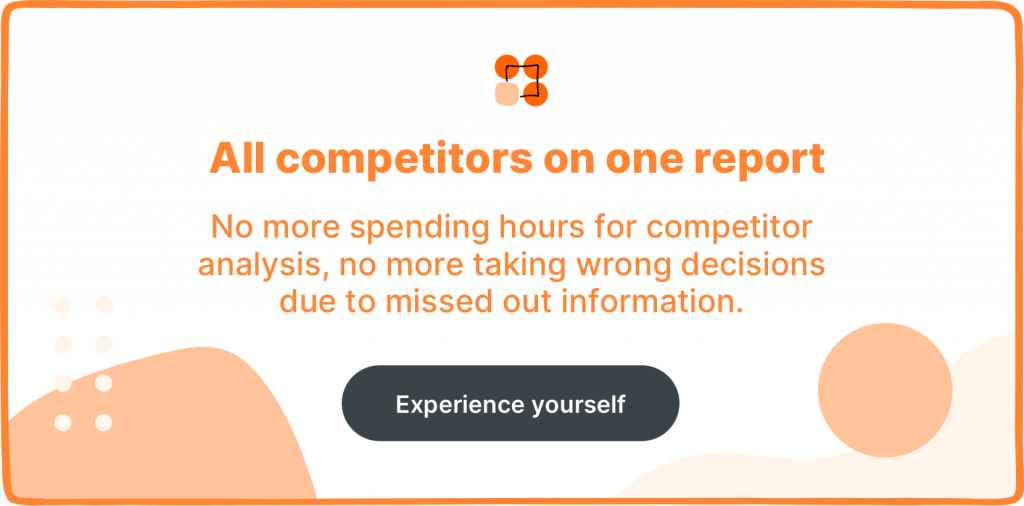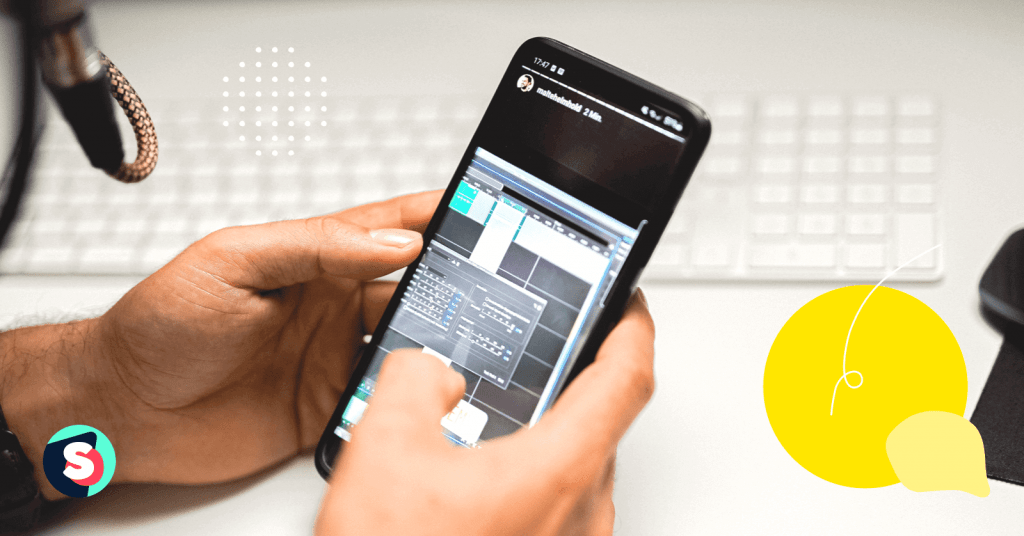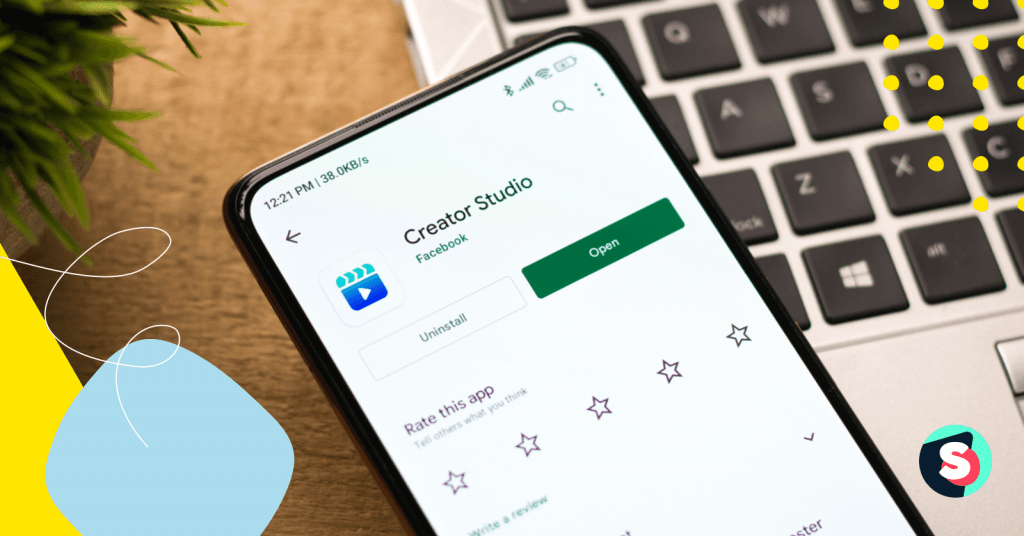You probably have some idea of how your social media content is performing.
But is it clear enough to really be actionable? And does it show you the full scope of potential a brand in your space can tap into?
There’s a simple way to peer into your competitor’s strategies without having to run any costly experiments.
You’ll be able to see what’s getting them a good ROI—and emulate it.
Worth checking 👉 How to define and measure social media ROI for your business
Plus, you’ll see what’s hurt their performance, so you can avoid taking the same actions.
The question, however, is, what exactly do you look for?
We’ve simplified that in this article, highlighting seven competitive benchmarking tactics that give you a comprehensive picture of the strategies your competitors have employed.
What’s more, you’ll also learn how to use them to get more context about your performance and precisely what’s needed to improve it.
Let’s get started.
What is competitor benchmarking?
Competitive benchmarking is the process of comparing your business against its main competitors using a specific set of metrics.
The idea is to gather data and use it to measure the company’s performance in comparison to others over a certain timeframe.
Think of it as an inside peek at what they’re doing right (and not so right).
You can leverage this information to discover weak points in your own marketing and sales efforts, business processes, or marketing strategies.
Plus, you could potentially uncover areas of new market growth.
As the saying goes, knowledge is power. Conducting an effective benchmarking comparison sheds light on where your company is positioned compared to the industry average, industry leaders, and your direct competitors.
Social media competitive benchmarking tips
Before we head into the specific tactics, there are some important tips you should know that can help you get more meaningful insights.
[Add button to competitor analysis report]
1. Combine benchmarking tactics
The competitive benchmarking tactics you’re going to learn about can give you a pretty good idea of your performance even when used in isolation. But if you want to gather greater context, you’re best off using a couple at the same time.
A period of negative follower growth, for example, may be tied to similarly negative sentiment.
Or a wise and informed change in posting times might be the explanation behind why your competitors’ engagement rate has increased so quickly.
By creatively pairing these benchmarking tactics, you can achieve in-depth visibility into how exactly your performance squares with competitors and the precise reasons behind the differences. Always take a look at the big picture, and consider all relevant social media metrics. Combine benchmarking tactics
2. Analyze multiple competitors at once
Focusing on one competitor presents a few risks. Firstly, you might think you’re performing horribly when, in fact, that competitor has simply stumbled on a jackpot strategy.
Alternatively, you may also think your social media performance is incredibly high and get complacent when that single competitor has just been having a bad streak.
The best way to avoid either pitfall is to look at as many relevant competitors as you can at the same time.
This way, you’ll be able to spot trends that apply to your space as a whole.
Some of the competitors you choose to benchmark against can even be indirect, giving you a wider field from which to draw inspiration.
And, with this amount of context about your industry and wider target audience, it’s all well and good to go after the highest performer and use them as a yardstick. At least you’ll have plenty of information to temper your expectations.
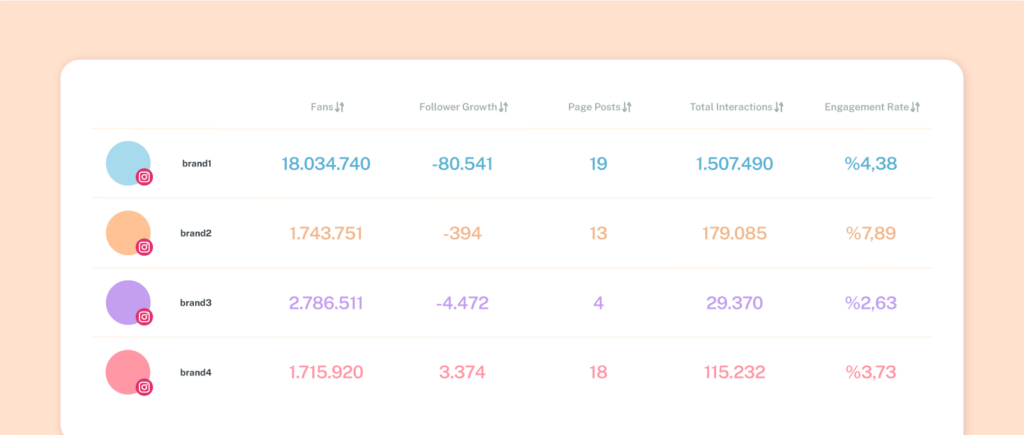
3. Focus on your KPIs
Although these five competitive benchmarking metrics are simplified and comprehensive, with all the fluff cut out, there’s still a chance that not all of them are useful to you at one particular time or for a given campaign.
What makes sense for you to look at depends entirely on the methods you’re using to gauge your performance. In other words, your social media KPIs.
4. Generate automated reports
Managing social media accounts and constantly tweaking your strategy to get the best ROI can be tough work. But, as you know, competitive benchmarking tactics are a useful tool for helping you achieve your aims and accelerate your growth.
You don’t want to let them fall by the wayside.
The solution is to schedule social media reports to be delivered to your email at a frequency of your choosing. This will drop regular social media insights right into your inbox, no manual labor required.
Social media management tools are the easiest way to manage and track social media analytics. Utilizing a social media report template can streamline the process further.
With Sociality.io, you can visualize your competitors’ data all in one place and extract detailed reports in minutes. Using a competitor benchmarking analysis template means you can benchmark based on data and sniff out your competitors’ top content.
There you go: All the competitor insights you need, but with a shorter to-do list.
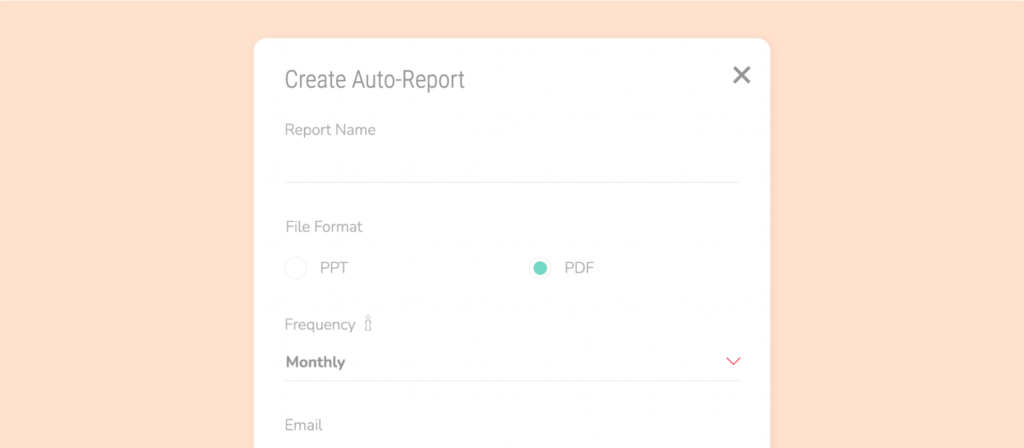
7 Competitive benchmarking template to measure your social media performance
So, do you want to benchmark your competitors to measure your social media performance?
We’ll be honest, there’s a lot to think about. From defining key social media metrics to carrying out a full social media audit, you’re going to need to gather some serious data.
The good news is that you don’t have to be a social media analyst to get your head around competitive benchmarking. Although, it certainly helps to have a good one on your team.
Here are seven competitor benchmarking tactics that work.
1. Content types
An obvious place to start with competitive benchmarking tactics is looking at the content types that your competitors are focusing on.
If their Facebook feed relies heavily on video, maybe they’ve figured out that it’s what gets the best results.
It’s the same with Instagram, where your competitors might be focusing on pictures, carousels, or videos as well. Same thing with Twitter.
You’ll find plenty of clues in their Facebook analytics and Instagram analytics, so dig deep.
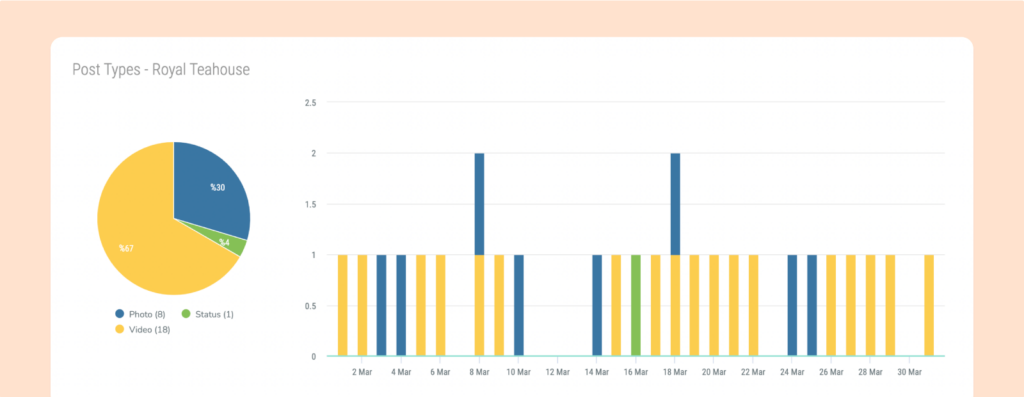
Knowing what to post is always a good starting point, so your content is the exact type that users naturally feel inclined to engage with. However, it’s unlikely that any of your competitors have singled out one type of content and called it a day. They probably have their own mix. Let’s compare it to yours.
What are they focusing on that you’re not?
Does this mean your competitors are dominating the content types your audience enjoys the most? Or does it mean you’re ahead, and you just need to secure the lead?
2. Top performing content
After getting a picture of your competitors’ content types seems to favor, it’s just as important to see which of their posts are performing best.
You’ll need to keep your KPIs in mind when doing this, so you remember which metrics are crucial to focus on for the strategy you’re hoping to implement.
Be sure to pay attention to various aspects of the posts. Things such as captions, tone, and the use of emojis can greatly boost a post’s performance.
Of course, you’ll also want to analyze the actual content: The graphics they’re using, the styling, and so on.
The type of content that counts as top-performing to you depends on your goals. And the filter options help to match your results to exactly what you’ve decided is worth paying attention to.
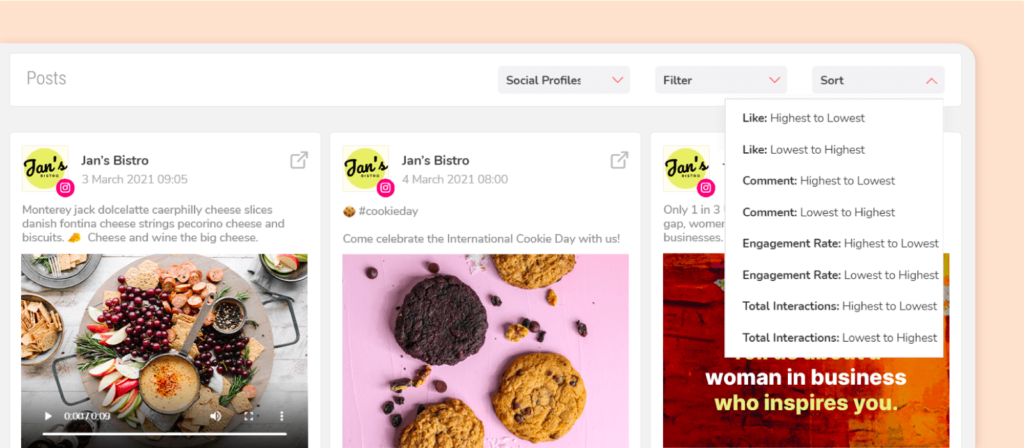
Once you’ve made your selection—let’s say for posts with the highest engagement rate to show first—you’re able to see the posts that performed best based on your chosen metric.
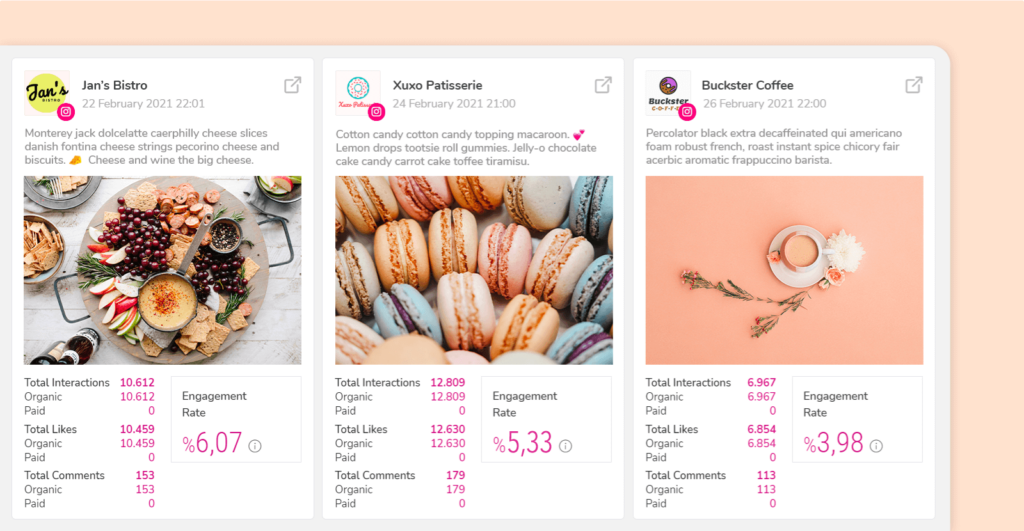
3. Timing and frequency of posts
Even though you’re now aware of the posts that could likely perform well if you emulated them, doing so is no good if you’re unaware of the right timing.
As the Harvard Business Review reports, posting at the most optimal time can increase ROI by as much as 8%.
For this, you can just take a look at when your competitors are scheduling their posts.
This was likely after some trial and error and extensive experimentation. Luckily, since you now know your shared target audiences’ most active hours, you can skip much of that process.
Similarly, you can also look into your competitors’ publishing frequency.
Are they posting once a day? Twice? Three times?
Knowing this can help you see if your publishing frequency needs improvement.
You can see if it’s too low to keep users engaged with your brand or if the frequency’s so high that it might be overwhelming your audience.
4. Follower growth rate
You can also look at your competitors’ individual pages and accounts to see if their followers have been increasing.
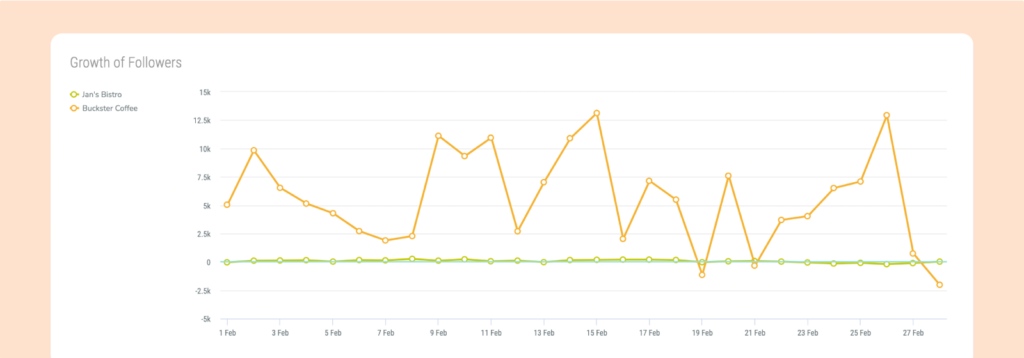
Related article: How to track competitors’ followers growth rate on social media
If their following is indeed growing, but yours isn’t, why is that?
Again, this is something you need to use other competitive benchmarking tactics to discover.
You can map a particular spike in growth to the types of content they were posting at the time, especially the top performers.
Better yet, if your competitors’ following took a plunge while yours stayed steady or even grew, then you know you performed comparatively well during that time.
You can circle back to the time frame, focusing on the things you unknowingly did right so you can make them a permanent part of your social media strategy.
But be careful to check what your competitors did wrong. Their blunders and missteps are worth avoiding just as much.
5. Interactions and engagement rate
As you know, part of running a social media account is engaging with audiences. It’s another area where seeing how your competitors are doing can give you a clearer idea of your own performance.
A general idea of how competitors’ content is connecting with your mutual target audience is certainly useful, but knowing the specifics makes for deeper insight.
This competitive benchmarking tactic adds depth to your understanding of how users feel about competitors’ content.
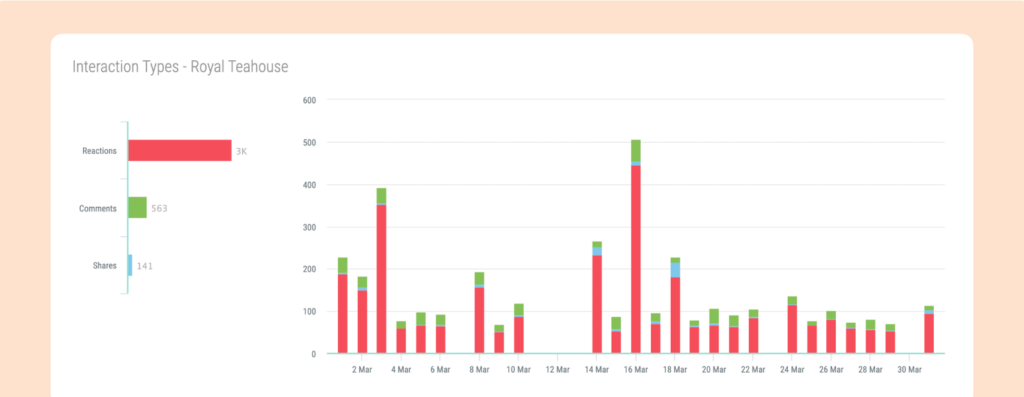
If you’re looking at reactions, for example, a large number of “laughs” probably tell you that your competitor has struck the right humorous note.
“Love” reactions, in the same vein, point to the content being perhaps uplifting and heartwarming.
A high number of comments may signal that the content addresses topics that users feel passionate about and they want to share their thoughts.
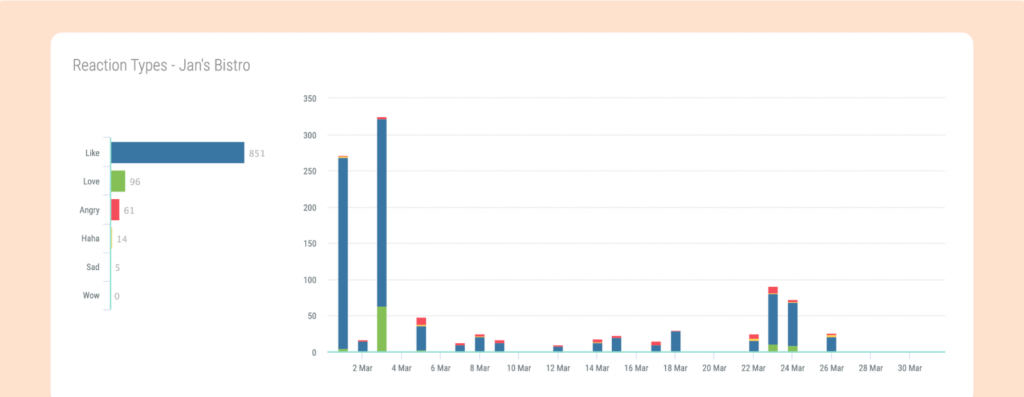
Now, make a side-by-side comparison with your own content.
Is it garnering the same engagement? Higher? Lower?
Compare the engagement periods, too.
It’s crucial to see what’s accounting for your competitors’ either high or low engagement. For example, engagement rates on Instagram have been shown to increase in direct proportion to the number of carousel slides.
6. Mention activity
This competitive benchmarking shifts the focus to your audience’s thoughts, feelings, and perceptions as they share them.
Using Sociality.io’s Listen module, you can get a clear idea of how often your competitors are being mentioned, for what topics, and by whom.
You can check for this across social media, blogs, news, and the wider web.
If Are your competitors the subject of conversation in topics that concern you and you’re not? What can you do to join those conversations, too?
Plus, you can see exactly when most of their mention activity is taking place and compare if the high and low time frames tally with yours.
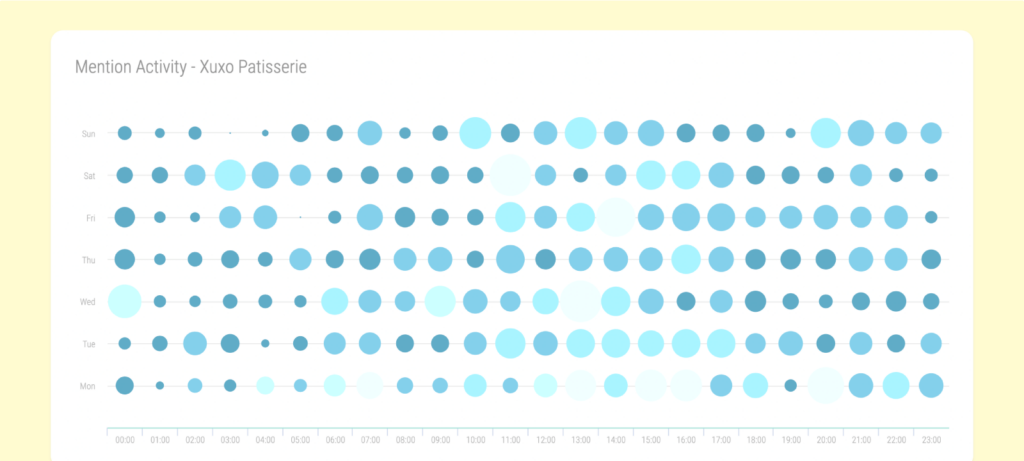
At the same time, if you’re being mentioned more, that’s a sign that your performance in that regard is better than your competitors.
Don’t get complacent, though. You also need to be careful to devise strategies to defend your ground.
You might even be able to spot posts with audiences directly comparing your brand to competitors once you enter the right keywords. It doesn’t get clearer than that.
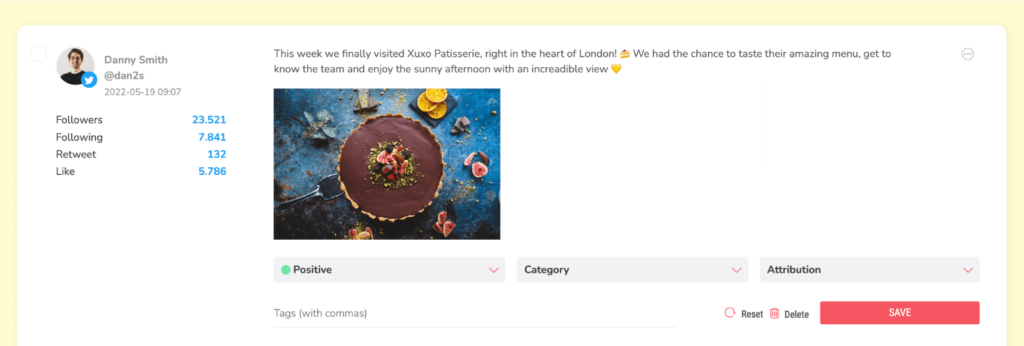
7. Sentiment analysis
It’s important to know not just what users are saying, but the feelings underpinning their posts and comments too.
That’s where sentiment analysis completes the picture.
You’ll be able to tell whether the comments are positive, neutral, or negative.
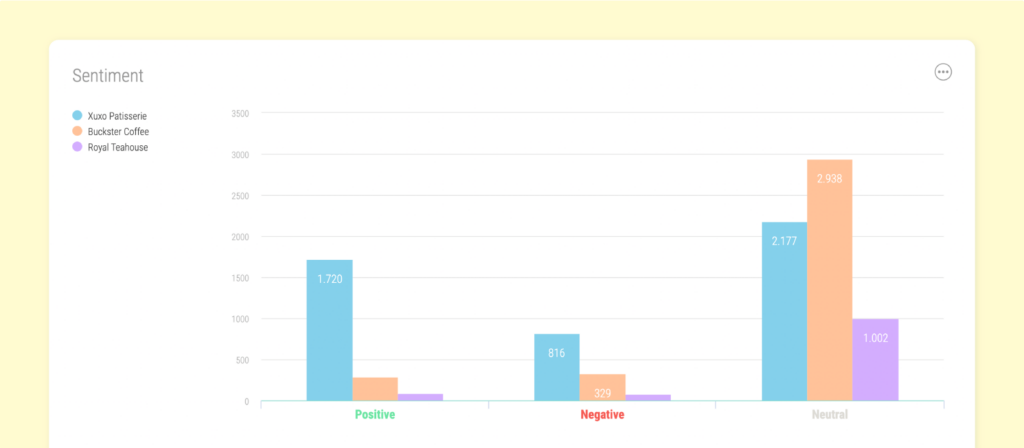
If your competitors are attracting more positive sentiment than your brand, that’s a sign that your performance could be better.
And you can look deeper into the substance of the mentions for a clearer understanding of what’s working so well for your competitors.
Likewise, if your competitors are struggling with this and your performance is higher than theirs, that’s a chance to note the things that your audience simply won’t put up with.
In closing…
You can only go so far in analyzing your social media performance if your own metrics are all you have to go by.
Once you start factoring in competitors’ performance, you gain a greater perspective on your performance. And you see previously hidden opportunities that competitors are leveraging, plus others they’re missing that you can be the first to take advantage of.
So, start using your competitors’ success and mishaps to measure your performance better and boost it. With the seven competitive benchmarking tactics above and a great competitor benchmarking template, you’re ready to begin right now.
